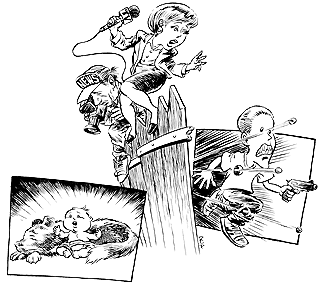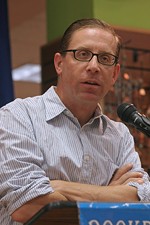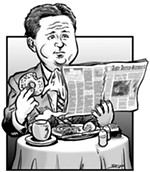Channeling the News
Watchdog Group Grades Local TV Stations
By Lee Nichols, Fri., Aug. 21, 1998
|
|
For the fourth year in a row, Rocky Mountain Media Watch (RMMW) has passed judgment on local television news in the United States. And the verdict, unfortunately, is a rerun of previous years: It's bad.
RMMW is a Denver-based media activist group founded in 1994 to, in its own words, "challenge the corporate media to provide citizens with better information." Since its inception, the group has done a yearly "snapshot" of local TV newscasts: RMMW picks an "average" day of news, one in which nothing too crazy has happened that might radically skew coverage in a particular direction (such as O.J. or Lewinsky), and analyzes how about 100 newscasts (102 this year) around the nation interpreted our world on that particular day. This year, that day was March 11.
RMMW's primary finding was the same as before: Local newscasts are too dependent on sensationalistic violence, and fail to deliver truly relevant news that can empower and enlighten viewers. Of the 102 lead stories this particular night, 57 dealt with either crime or disaster. And of the total time devoted to news coverage, out of 26 categories of possible news topics, crime and disaster ate up 39.1% of it. Meanwhile, items such as overpopulation, abortion rights, AIDS, and peace combined for less than 1% of the total.
The report, titled "Not in the Public Interest: Local TV News in America 3/11/98," concludes that television newscasts simply arouse our emotions to make us more susceptible to advertising propaganda. The watchdog group calls on viewers to look at local broadcast journalists with a critical, activist eye, and to demand that if the stations are to be allowed to continue using our airwaves (which legally are publicly owned, used only by the permission we grant via the Federal Communications Commission), then they should actually serve their respective communities, rather than merely titillate them.
With a little help from "Media Clips," this is the first time that all four Austin stations were included in the study (we provided RMMW with tapes of two of our four local newscasts; local activist Bill Jackson provided the other two), and we can't help but be interested in how our local quartet represented itself in the study.
In fairness to the stations, it is important to keep in mind the nature of the study - it is intended to be a national composite of local newscasts. Pulling out an individual station and examining its numbers doesn't provide much definitive information about the nature of that station's typical broadcast; it merely shows what happened on that particular day.
That said, our home teams actually came out looking good in several respects, although improvements could be made in others.
The most notable news of local import was the praise that RMMW heaped upon KVUE. The ABC affiliate was one of only four stations "whose newscasts stand out for quality, intelligence and creativity," the report says. RMMW is especially fond of KVUE's stance on crime coverage, noting the station policy, instituted in 1996, that restricts coverage to those incidents which actually have a significant impact on the overall Austin community. "KVUE-TV remains the number one rated station in Austin [actually, NBC affiliate KXAN has since passed KVUE] and is an inspiring model for TV stations that want to wean themselves from the excessive violence that has come to characterize so many newscasts," the report states. KVUE was also praised for a story on citizens' views on downtown growth, expansion, guidelines, and bond issues. RMMW said the story was "not only well done" but also "help[ed] empower the viewer with tips, advice, solutions and actions."
KVUE was not beyond reproach, however: It was also among several stations criticized for obnoxious, "whooshing jet-like sound effects," and for chest-beating self-aggrandizement for constantly letting us know that it won the award for "Associated Press's best newscast in Texas." The report also needled KTBC ("Fox-7") for the jet noises, but mistakenly credited that station for constantly beating us over the head with the "First. Best. Live." slogan (actually, that's KXAN). "Humility is not a major trait of local newscasts," the report moans.
Interestingly, the report doesn't mention that KVUE was not our city's leader in limiting crime coverage on this particular viewing night - KXAN only spent 4.4% of its total news time on crime (almost the best in the nation), compared to KVUE's still-commendable 13.4%. Perhaps that is why KXAN has moved to the top of the ratings.
Fox-7 also squeaked under KVUE in crime percentages with 13.2%, but we can only conclude that RMMW caught them on a good night. When "Media Clips" did a similar, but week-long, study two months earlier (Feb. 20, 1998), we found that crime averaged 36% of Fox-7's news hole. K-EYE, the CBS affiliate, was the lone scare-monger of the night, with 36.4%, making it the 24th highest among the 102 stations.
K-EYE did a little better in the overall mayhem rank (crime and disasters combined) - since it only showed crime, its 36.4% put it at 56th. The other stations, meanwhile, were excellent: KVUE was 93rd (15.9%), Fox-7 was 95th (13.2%), and KXAN was 97th (11.4%).
Whatever Fox-7 lacked in overblown crime coverage on this particular night, it unfortunately made up for in "fluff": previews/promos, anchor chatter, soft news, and celebrity stories. RMMW found that of the total half-hour broadcast, the ratio of fluff compared to actual news was 45.7%, meaning that if 10 minutes were spent on news, another four and a half minutes was spent on banality. Four minutes is a huge chunk of time in the world of TV news - and in fact, Fox-7's ratio of fluff to news ranked it third worst in the nation. The other stations were considerably better, ranking from 73rd (K-EYE, surprisingly low at 18.2%) to 93rd (KVUE, 13.4%).
Looking at other raw numbers, Austin's stations all did poorly when it came to filling their broadcasts with actual news. The best was KXAN with 37.4%, ranking a paltry 67th overall. Fox-7 scored a pathetic 31.9%, putting it 96th in the nation.
Maybe that is because the stations have too many commercials: All four stations finished in the top 28 for having the most commercial time per broadcast, K-EYE coming in at number two. The report specifically berated 15 stations for having more commercials than news, and three of them were ours: KVUE (34.6% news vs. 35.7% commercials), K-EYE (34.2% vs. 38.7%), and Fox-7 (31.9% vs. 32.5%).
But readers/viewers may be wondering, "Do these numbers really matter? Aren't all local newscasts just different degrees of bad?"
Definitely not. KTCA, a PBS station in Minneapolis-St. Paul (the only non-commercial station in the study) sets a brilliant example for the rest of the nation. It ranked first in the nation for news time (75.5%), had the lowest amounts of crime and mayhem (none), the lowest fluff-to-news ratio (4%), and the lowest commercial time (March 11 just happened to be during a pledge drive, and pledge pitches took up 20.3% of the broadcast; otherwise, the "commercial" time no doubt would have been even lower).
Commercial broadcasters might complain that this is comparing apples with oranges. Obviously, the public station has certain advantages: KTCA's broadcast is a full hour, and by its nature, it will naturally be low in commercial time; therefore, there's more time for hard news. But on the other hand, there are also disadvantages: Given that the station must struggle by on public funds instead of being a for-profit enterprise, how can this station kick the butts of the rest of the nation?
So what do these numbers mean for Austin's TV news viewers? Well, as said, it was only one day of news, but the study seems to indicate that while Austin could have it a lot better, things could also be a lot worse. Somehow, that seems to be small comfort. Austin has proven time and again that it has one of the best-read, most politically active, and most enlightened populations in the nation. We deserve better than just "mediocre" - which, with the above-noted exceptions, is what we are getting.
For copies of "Not in the Public Interest: Local TV News in America 3/11/98," send $20 to: Rocky Mountain Media Watch, Box 18858, Denver, CO 80218. RMMW can be reached at 303/832-7558; or go to http://www.oneimage.com/~rmmw/.
Making Waves
Okay, that's it. We've had it. "Media Clips," which has thus far been restrained in its opinion toward the KOOP board of trustees and its allies, has decided to officially side with the move to recall the board.
It has become clear that the board and its allies - or "the cadre," as they have become known - are at best delusional and at worse power-hungry, and if allowed to continue their reign, will bring the station to ruin.
The straw that finally broke our camel's back was a recent rant by trustee Mac McKaskle on his Queer Waves program. McKaskle hysterically repeated charges that the recall move was "based on racism, based on sexism," and asserted that certain people wanted him removed from the board because he is homosexual.
McKaskle also made the ludicrous claim that Chronicle editor Louis Black editorialized against the cadre ["Page Two," July 17] because "he's feeling the pressure that he's going to have to open up his publication to more voices and more people." He also said that Statesman radio columnist Rob Patterson took an anti-cadre position because "we [KOOP] have pressured this huge, huge multinational corporation who is feeling upset at what we're doing here."
Mac, get a grip. Although the Chronicle, like many newspapers, could benefit from greater racial diversity, the paper's editorial staff is about half female, and has quite a few gays and lesbians, including many people who are in positions of authority. And if you think that anyone at Cox Enterprises (the Statesman's parent company) really gives a rat's ass about this tiny, 3,000-watt station, you have delusions of grandeur.
In fact, you [meaning the cadre as a whole] are creating fictional divisions. Why are so many of your most vocal opponents gay? Why are so many Hispanic? Why did an ardent feminist who used to work for KOOP complain to me that, "It got so P.C. down there [at KOOP] that I couldn't move"?
No, Mac, maybe the problem isn't that you're gay. Maybe the problem is just you.
Got something to say on the subject? Send a letter to the editor.









